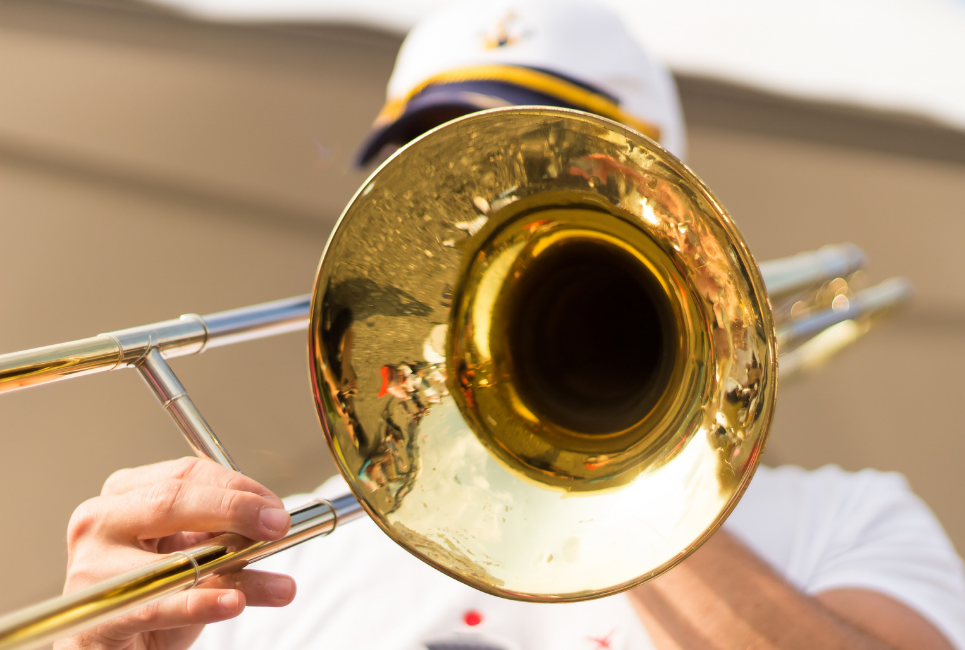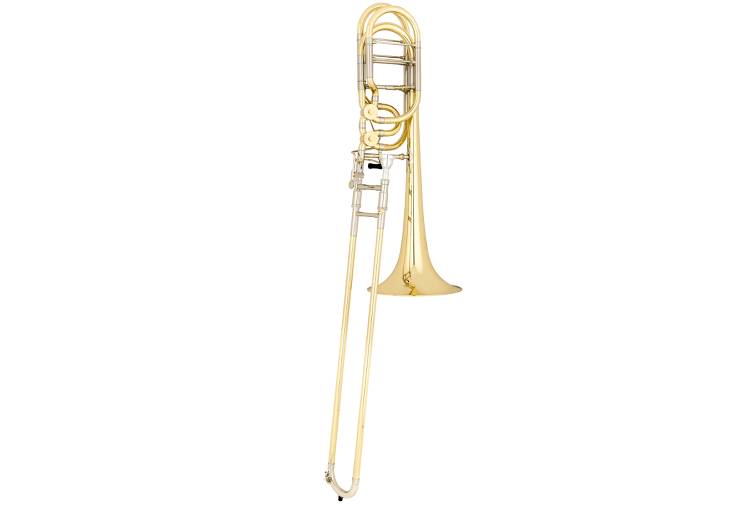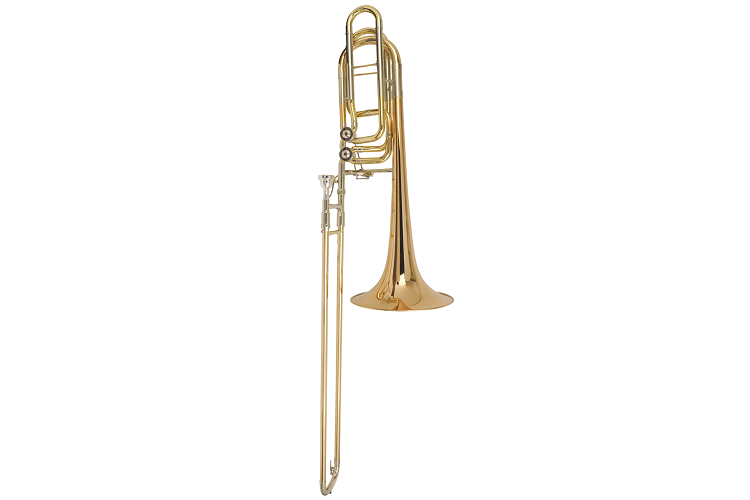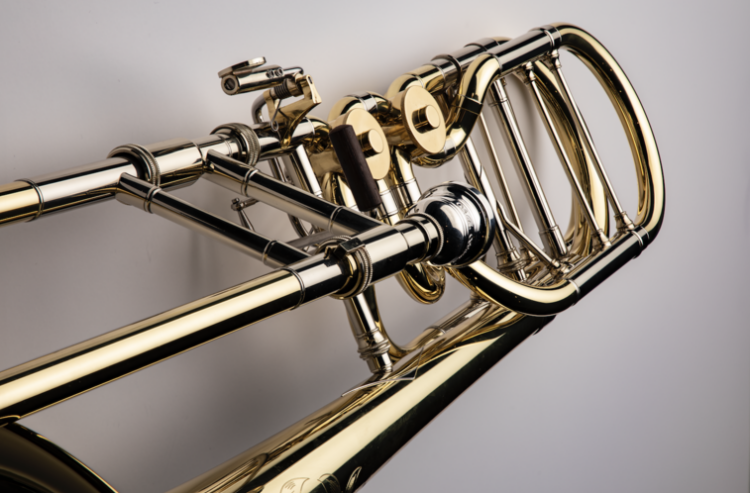- How to Find the Best 5 String Violins - April 19, 2022
- Top Violin Accessories to Consider - April 18, 2022
- Best Left-Handed Violins Guide - April 13, 2022
Summary: Knowing how to find the best bass trombone comes down to picking the right size and design based on your skill level. A bass trombone is an excellent option for people who want to play those richer, lower notes.
When people think of a trombone, they always picture a big brass instrument with a slide. In fact, most people imagine it with the sound of the sound associated with failure:
Silly sounds aside, there are many trombones, so knowing how to find the best bass trombone starts with understanding the family of instruments.
Trombone Family
The trombone family consists of seven different members, each divided into their size category. While there are technically seven, only three are trombones you are likely familiar with. Two of the seven family members are considered primary instruments. At the same time, the rest are usually secondary instruments added to an ensemble or group that already has one of the two primary instruments.
Going in order from largest to smallest you have:
- Contrabass trombone
- Bass trombone
- Tenor trombone
- Alto trombone
- Soprano trombone
- Sopranino trombone
- Piccolo trombone
As I said, out of all seven of these, the tenor trombone and the bass trombone are actually the two main sizes, so these are the two trombones that most musicians play. If you have ever seen a trombone in a brass group or a high school music class, it was very likely one of these two.
When people casually refer to a “trombone,” they refer to the tenor trombone. This is the most popular, followed by the bass trombone. If you are looking for the best bass trombone, you might play alongside someone who is already playing the tenor trombone.
If you play the tenor trombone yourself, you might double your skills by also playing the bass trombone. Because there is a lot of crossover between these two popular instruments, it’s pretty common for musicians to learn to play both.
Why are the tenor trombone and bass trombone the most popular?
So many people play a tenor trombone and the best bass trombone because they share similar mouthpieces, so the size is the same. This makes it very easy to apply the same technique to both instruments.
This video gives you a chance to hear what a jazz bass trombone sounds like on its own:
Parts of the Best Trombone
To understand which features are most important when evaluating the best trombone, you need to know the different parts of the instrument.
When you look at any trombone, you see the same general parts. Starting at the back end, the position that faces your body, you have the round tuning slide.
At the top end of the tuning slide, there is the F attachment which runs the length of the instrument and then expands to the bell tube and finally the bell, which is the large amplifier that faces the audience.
At the bottom end of the tuning slide, you have the F rotary valve, after which is the F lever. The long section of tubing that extends outward contains the water key at the very front end, the Ferrule at the top, the outer slide tube (inside of which is the inner slide tube), then the brace, the slide lock, and the mouthpiece.
Features of the Bass Trombone
So I’ve mentioned that the bass trombone is the second most popular and the second largest. Still, it shares quite a bit in common with the tenor trombone. It is pitched in Bb (B flat) just as the tenor trombone, but it has two rotary valves.
The Importance of Two Valves
Values are what you press with your fingers to move the notes up and down. The two rotary valves enable the bass trombone to play notes lower than the tenor counterpart.
- The first valve transposes the best bass trombone into F, the same as the F attachment for a tenor trombone.
- The second valve can transpose into Gb (G flat) or G depending on your preference.
If you engage both valves, you can transpose the bass trombone into Db (D flat) and D, respectively.
The second value is unique because it can be independent or dependent.
- If it is set up in the dependent configuration, it can only be used with the F attachment.
- If it is set up in the independent configuration, it can be used without the attachment.
Bells
The bell, mouthpiece, and bore size are also larger than the tenor trombone, which provides darker, richer sounds when you play low notes but comes with the drawback of murkier and less precise high notes.
The bell is what allows the sound waves to leave a brass instrument. Think of it as a speaker. The harmonics, power, and bravado all originate from the bell. Without it, the audience would not be able to hear your music.
The bell size is referred to as the “flare.” The smaller the bell size, the sharper the sound, while the larger the bell size, the more mellow the sound.
It is the wide opening at the end. The bell flare size is typically between 9 ½ inches and 10 ½ inches for a bass trombone. The thickness of the wall varies from 20 (which is the heaviest) up to 23 (which is the lightest) gauge.
Thickness (or gauge) matters too because a wider gauge means a rounder round and more direct projection while a smaller, lighter gauge implies the opposite.
This video shows a bit more about the bass trombone:
Bore Shape and Size
When looking at the best bass trombone, you should consider the bore shape and size. Bore shape refers to the shape of the tubing on your instrument. For brass instruments, the tubing can be conical or cylindrical. For trombones, you get a cylindrical shape that retains the same diameter until the bell, at which point the bore flares.
Trombone bores are often listed in three sizes:
- Small-bore
- Medium bore
- Large bore
The smaller the bore size, the less breath you have to put into play, and the more mellow the timbre.
So, small bores are best for beginners. Medium bores are best for intermediate players. Large bores are preferable for advanced musicians.
When reading the bore size, you might instead see it listed by size, which is usually between 0.485 inches and 0.562 inches. The bass trombone is toward the medium or higher end of that scale.
Open or Closed Wrap
When you look at different bass trombones, you can choose between an open or closed wrap. Traditionally both sections of the bass trombone are wrapped within the body so that you get some protection and compactness. Some manufacturers provide an open wrap design which means that your rotor sections have fewer bends, so you get a more free blowing trombone. This is only something I would recommend for advanced players because the open rap configuration is unique, expensive, and is usually combined with a free blowing rotor, so it takes a little bit more finesse and expertise to handle.
How to Find the Best Bass Trombone
All of these features are very important but finding the best bass trombone means figuring out which sound and feel you like best.
Have a Budget
Always have a budget in mind. The bass trombone can be a rather expensive instrument, so if you cannot afford to invest in a new instrument, you can always look for used models in good condition or consider renting from a nearby music school.
Try Different Mouthpieces
When you set out to find the best bass trombone, you really want to try different mouthpieces. If you already have a tenor trombone, you can choose to use the same mouthpiece for both instruments or buy two of the same mouthpieces to have the same feel no matter which instrument you use, or you can purchase completely different mouthpieces.
Test the Sound
If you can, I recommend testing different instruments. Finding the best bass trombone means finding an instrument with the sound and tone you like most. Not all models sound the same.
Manufacturers use different materials and slightly different compositions for things like the body of the tubing or the finish, and all of this can impact the sound. The bass trombone is a very low instrument, so you want to test the intonation before you invest thousands of dollars in a new trombone. Always bring a tuner if you are going to try your trombone.
When I first bought a trombone, I left my tuner at home, and I didn’t think anything of it because I was already familiar with a tenor trombone. However, this meant I couldn’t test the intonation or the sound correctly.
I bought the bass trombone, and the very next day in school, I realized that many of the other band members were trying to match my pitch because they could hear me, but my trombone wouldn’t stay in tune. Eventually, I had to return it and get a new one.
Play Different Models
Every manufacturer puts a slightly different spin on the design of their bass trombone. So, to find the best model for you and your situation, you need to play with other models. Don’t just try one model because it’s the cheapest, and don’t try one model because it’s the most expensive.
The most expensive instrument won’t compensate for lack of skill, and the cheapest instrument won’t help you show off your skill. So play different trombones until you find the one you personally like best.
When I set out to buy the bass trombone that I would stick with for years, I went to four different instrument shops, spent hours online, and played six other models before I found the one I liked the most. It was worth all of the time because I still have that instrument today.
The Best Bass Trombone
The best bass trombone will vary based on your skill level and personal preferences, however, I have different recommendations for beginners through professionals.
Eastman ETB848
Beginners might also like the Eastman ETB848. This is one of the most affordable and has customizable options for beginners. I like it because the valves are independent. I am also a fan of anything that comes with a case and all the things you need to get started.
Pros
- Comes with a mouthpiece and case
- Has a yellow or gold brass bell depending on what you want
- 3 lead pipes
Cons
- Not suitable for orchestral performers
Conn 112H
For beginners and intermediate players, the Conn 112H is a reputable model with independent rotors. The outer slide is very lightweight so it is easy to hold. I like this for beginners because it comes with a case and everything you need to get started straight away.
Pros
- Lightweight with a good sound
- Has a mouthpiece and case
- Easy to hold for beginners
Cons
- Not meant for professionals
Yamaha YBL-822G
Yamaha is incredibly well known for many instruments. If you are an intermediate player, I recommend the YBL-822G. This has a yellow brass exterior with nickel silver inside. The brass bell and dependent rotors help you achieve a richer, warmer sound than other instruments.
Pros
- Good for orchestra or ensemble music
- Perfect for intermediate musicians
- Warm, bright tone
Cons
- Smaller mouthpiece than you might want
S.E. Shires Q-Series
For professionals, I recommend the S.E. Shires Q-Series bass trombone. The exterior comes with a lacquer finish, gold brass bell, and yellow brass lead pipes. This model comes with a mouthpiece and case so you can take it out and start playing immediately.
Pros
- Warm and rich sound
- Ideal for professionals
- Intricate artwork on the exterior
- Easy to customize
Cons
- Not meant for beginners
FAQs
Answer: As mentioned, the trombone or tenor trombone is very similar to the bass trombone. The instruments are the same length, but the bass trombones can project lower notes more effectively because they have larger bells. Bass trombones also have two rotors so that you can play notes that go far beyond the lower end of the tenor range. To account for these lower pitches, the bass trombone has additional tubing at the instrument’s back.
Answer: Because they are some of the largest trombones, most bass trombones will cost between $3,000 and $7,000. The cost is entirely contingent on the level, such as a beginner student level or a professional level, as well as the brand you select. If you are starting, the price of even a student model bass trombone might be a bit expensive, in which case you can rent trombones from music schools or invest in a used trombone.
Answer: Any current trombone player who wants to add a second instrument to their musical repertoire should learn to play the bass trombone. This is an excellent choice for people who wish to diversify their skills to have a competitive advantage when it comes to orchestra or band music.
The more wind instruments you can play, the greater flexibility you will have, especially when an existing brass quintet, orchestra, or other ensemble has sheet music for a specific part but no accompanying instrument.
Bottomline
The bottom line is knowing how to find the best bass trombone means finding an appropriate material, finish, and size for the bell and the diameter. The bass trombone is the second most popular trombone, and with just a little bit of practice, you can learn to provide steady breathing and make deeper, richer tones that contribute to the fullness of an orchestra or an ensemble.





